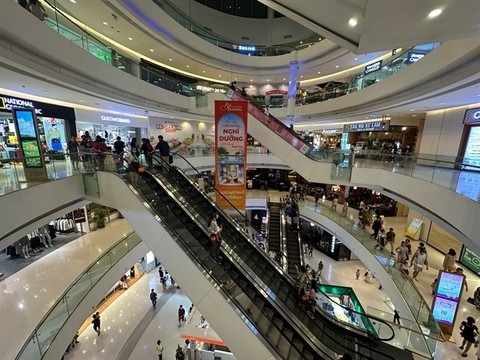|
Retail centres to pay more attention to green standards
Investors of new shopping centres and retail spaces in Việt Nam are gradually paying more attention to green standards from the very first steps of development, experts said.

A shopping centre in HCM City. Investors are paying more attention to green standards at shopping centres and retail spaces. — VNS Photo Thu Ngân
|
As responsible and ESG investing gain traction, the focus on sustainability has become a top priority for investors, developers, and property owners in Việt Nam.
This shift emphasises the importance of aligning strategic goals with market demands towards more sustainable practices rather than just focusing on luxury developments.
According to a Cushman & Wakefield forecast, by 2027 there will be a total of 3 million sq.m of retail supply serving the two largest cities of HCM City and Hà Nội.
Projects that are in the development stage such as Lotte Eco Smart City, Empire City in Thủ Thiêm new urban area in HCM City, or projects in cell C1-CC1 of Starlake Tây Hồ Tây new urban area in Hà Nội are working towards LEED (Leadership in Energy and Environmental Design) green building certification.
Similarly, quite a few commercial centres under construction, such as Tiến Bộ Plaza in Hà Nội, have also registered for the LEED standards assessment.
“The addition of green building certifications can help enhance the developer's corporate image and the reputation of the developments. Another advantage for investors and developers is that environmentally friendly commercial buildings often have higher rents, better market prices, and are also more resilient to any market downturn,” said Trang Bùi, country head of Cushman & Wakefield Vietnam.
Shopping malls are diversifying their offerings beyond shopping to attract visitors of all ages and lifestyles, incorporating food, beverage, fashion, supermarkets, cinemas, children's play areas, fitness outlets, exhibitions, music venues, green spaces, and even aquariums.
Brands like Pizza 4P are also embracing green certifications, with the Pizza 4P store at Lotte Mall West Lake Hanoi recently earning LEED Gold certification for its interior design and construction.
“Investors, developers and commercial property owners in Việt Nam must now understand the fact that over time, the principles of responsible investing and ESG investing are becoming more and more popular. And this has also pushed investors and developers to transform their strategic goals of sustainability into a top business priority in line with capital market requirements, rather than simply developing luxurious buildings,” Trang said.
The total retail supply of Việt Nam’s market started at about 30,000 sqm since the first shopping malls opened, including Tràng Tiền Plaza in Hà Nội and Tax Trade Centre in HCM City.
According to Cushman & Wakefield’s data, from 1996 to 2019, the market welcomed 97,000 sqm of retail space on average each year. In particular, the retail market grew strongly in 2013-2019 with 195,000 sqm of new retail space being launched each year.
By 2023, the total retail supply in both cities will reach about 2.5 million sqm from 137 projects.
According to a study by Cushman & Wakefield, Millennials and Gen Z are currently the main economic drivers and are constantly finding ways to make a difference in the world. Thus, they prefer companies that value social responsibility and environmental sustainability.
To attract these generations of consumers, developers are not only adding new restaurants and retailers but also placing more emphasis on sustainability.
Although Việt Nam does not have mandatory regulations applicable to green buildings, green building development is usually carried out in a voluntary manner.
Many old buildings have been on the market for many years with no green certification, and new buildings have the advantage of achieving green building certifications from the get-go. As of end of March 2024, the number of green buildings in Việt Nam has reached over 430 projects with a total area of about 10 million sqm of construction floor space.
The next challenge for cities is to ensure green building practices can become the norm. This requires the market to create a business environment that values green spaces and their developers.
Renovating existing shopping centres to reduce carbon emissions and improve efficiency will be crucial, involving measures like air pollution control, the use of renewable materials, implementing technology for energy efficiency, and optimising spaces to be more eco-friendly and cost-effective.
Despite the evolving retail landscape driven by factors like population growth, e-commerce, and digital adoption, Việt Nam's retail sector is progressively moving towards a sustainable future.
Through collaborative efforts across the market, the vision is for green building practices to become the standard in Việt Nam in the coming years, fostering an environment that prioritises sustainability and environmental stewardship.
Bizhub
|